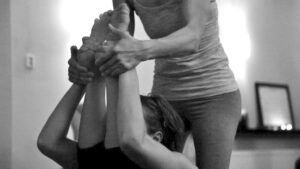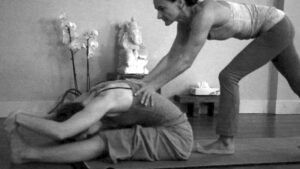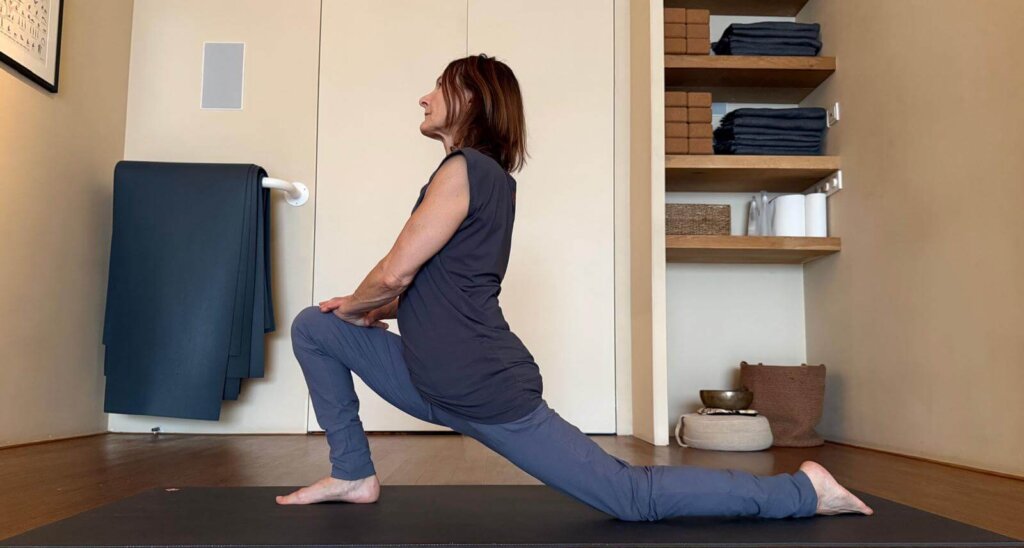THE MYSORE WAY TO LEARN ASHTANGA YOGA
By Claudia Pradella
I’ve practice yoga alone most of the times, since the very beginning – I started with private tuitions with a lovely teacher who used to give me “homework” to do by myself in between sessions. I occasionally went to yoga classes, but mostly I was alone or with my teacher. My first Mysore practice was in London back in 2003, in a big room with over 40 people. I was visiting London at that time, so I was only there for that one class. I knew the practice – more or less – but I felt highly intimidated by the size of the room, the large number of people there, each of them working quietly on their own practice, the loud sound of ujjayi breathing filling up the room. They all seemed to know very well what they were doing, and to me – they all looked like very advanced practitioners! Not much really happened in that room on that day, I virtually received no adjustments, maybe a couple of verbal cues, but there was something special about the experience, which left me with a strong longing to find out more about that way of practicing Ashtanga yoga. But no mysore practice was available once back in Holland. Practicing with a few friends in a heated room, just wasn’t the same.
In 2005 I finally made it to India. It was in Kovalam, South India, that I first met my Italian teacher Lino Miele. A minimum of 1 week was required to practice there. I had the time so I decided to try. That Mysore room was even bigger – the first group of students were starting at 4:30 am (!!!) and by the time I arrived to practice 3 hours later already nearly 100 students had finished their own practice… I couldn’t believe it. I waited until a spot became available and Lino called my name. Then I walked in the room, unrolled my mat, and started my practice. I was a little shaky, like being under exams, but also over excited about the intensity of the room. Lino was very present to each student, like he knew each person very well, and his 5 assistants were offering a lot of adjustments and help in various poses. There was not a dull moment that morning, my attention was split in between sneakily looking around trying to figure out what was happening around me, and my breath when taken deeper in a pose. I lied on the floor to take rest at the end of the practice, happily exhausted and totally soaked, with a deep sense of being alive and in love with this practice. There was something magic in that room….

A month later I was in Mysore – the real one. In the city that gave the name to this practice, with the teacher that dedicated his whole life to teach this method: Krishna Pattabhi Jois. His daughter Saraswathi and his grandson Sharath were helping him during class. While I had already met him in London on 2 previous occasions, this experience had a different flavor to it. I was practicing in his own home, in “the” mysore room, and I had committed myself to return every morning at 6am for a whole month of intense daily practice. And it was intense indeed, physically mentally and emotionally, but one of the most rewarding experiences of my life, as I began to really understand this system and the way it uniquely worked.
First of all, there is the discipline – it takes some commitment to show up on the mat every day at the same time, 6 days per week! Particularly on those days when I really didn’t feel like it, when the back was hurting, or when I was just too tired to get up. But the discipline paid off, as I started to trust myself, rather than doubting I was going to do it. I somehow become responsible for my own practice. Excuses were just no longer good enough.
Progress was really fast and visible – and it’s not about “getting more poses”, but moving every day deeper into wherever you are. The daily repetition of the same sequence really allowed me to see myself clearly, reaching also those corners which I had often avoided. And by some magic, this translated into becoming able to do things they seemed at first impossible. As the mind becomes more flexible, so the body begins to let go of long held tension and to open up in these ridiculous shapes we put ourselves in…!
The heat in the room, the group energy, together with those unexpected adjustments from the teacher made me accomplishing things I would have never considered possible.
And there’s this amazing connection with the teachers, which builds up day after day, practice after practice. They say in a mysore room you get a private class in group settings. I never really discussed things with Pattabhi Jois or with Sharath, but somehow they was there for me and knew me, knew my practice – not my name! – but knowing my practice they knew very intimately my strengths and my weaknesses, my fears and my ambitions. They knew when I needed help and support, and also when I needed to be challenged or ignored. It’s a very unusual type of relationship, but a very special one. While I’m just one of the hundreds of students they see in a day, they could really see me. And I could only trust and surrender each time I felt them walking towards me (and keep breathing)…
There’s also a very unique bond with the other students in the room, we don’t know each other, I’ve never spoken to some of them, but I know their breath so well, we’ve been sweating next to each other, caring for each other space, aware of each other practice without being distracted by the other. As I recognize the struggle, the frustration, the joy of the others, each moment being different, I acknowledge the support I also receive from the others, which helps me to go through my own difficult moments of practice. This is the power of Sangha – it’s so much easier to practice in a room with others than home alone!
Once I was back in Holland, again I missed so much having access to a Mysore room. I cultivated my practice over the years in the hard way, that of practicing alone most of the time, and having to plan time off every year to travel to my teachers and practice with them abroad. Because practicing with the teacher is the foundation of the Ashtanga system – Parampara is knowledge that is passed in succession from teacher to student. It is a Sanskrit word that denotes the principle of transmitting knowledge based on direct and practical experience, rather than books or videos.
The dharma, or duty, of the student is to practice diligently and to strive to understand the teachings received. The perfection of knowledge – and of yoga — lies beyond simply mastering the practice; knowledge grows from the mutual love and respect between student and teacher, a relationship that can only be cultivated over time. The teacher’s dharma is to teach yoga exactly as he learned it from his teacher and experienced directly. The teaching should be presented with a good heart, with good purpose and with noble intentions. The shala becomes then a safe space for practice, where trust and knowledge is cultivated and nourished every day from both the teachers and the students.

So if you do have access to a Mysore room – and you probably do, because we offer a Mysore Program at Yoga Circle and there are many more nowadays in the Netherlands and beyond – take this opportunity and go practice there!
If you are new to the concept of self practicing under the guidance of a teacher, you can join an Ashtanga Beginners class. You will then be given the details of how to work in a mysore room and you’ll be guided through the foundation part of the sequence which you can start to memorize. But of course you’re always welcome to just join the regular Mysore Program with no previous experience. It is an all levels practice and everyone is welcome!
These are some suggestions on how to prepare for a Mysore Practice:
– it is useful (but not necessary) to go to an Ashtanga Led class first. In the led classes you hear how to move with the breath in and out of each pose. In your mysore practice, you’ll be asked to pay attention to each movement, each breath, and smoothly connect poses with the prescribed amount of breaths & movements
– patience is the main requirement: it takes time to build a regular practice, so you want to consider investing a couple of months in this starting phase
– consistency is next: try to stick to the same shala for a while, and practice at the same time of the day. Make sure you keep at least 24 hours in between practice and at least 1 day of rest in the week
– be realistic about how often you will practice at first: make a plan beforehand to see how and where to squeeze the practice into your daily schedule. It is best to practice in the morning, but we offer mysore classes in the evening as well on Monday, Wednesday and Thursday. While it is meant as a daily practice (6x a week), it might be best to start with 3x week to make sure you minimize the struggle and maximize the success. If that works just fine for you, then add an extra day of practice either at the studio or at home
– repetition is key in this practice: better to practice more often for a shorter time than having a longer practice once a week. A saying goes that it takes 1000 repetitions to master a yoga pose!
– practice can take from 30 to 120 minutes! As you start, you will be guided through the sun salutations, which are the foundation of the practice, and will be asked to repeat them at your own pace. This might take just 20 minutes, followed by a short rest period. Or you might start already with a longer practice, depending on your previous experience and your ability to memorize the sequence and do the poses. It’s different for each person, so just be open to the suggestions of the teacher
– come to practice on an empty stomach (at least 2 hours from a meal if it’s in the evening), take a shower before practice and wear clean clothes. You might want to bring your own mat if you have one. You can always use the studio mats provided in the shala, but if you buy your own mat, you will be more likely to do some extra practice at home
– tell the teacher about any injuries, pains or sensitivities you are experiencing in your body, but also emotional or mental difficulties you might be going through have an impact on your practice. It is really useful for your teacher to know and it will of course be a confidential conversation. This practice is accessible to anyone, but depending on what is going on in your body/mind it might be advisable to modify some poses. Trust the teacher
It takes some time, effort and perseverance to build this practice. But once the routine is in place, you will start harvest the many benefits of this practice and it will be your own practice, always available, wherever you are and wherever you go. It will continue to grow with you. Breath after breath.
Enjoy your practice. Always.



